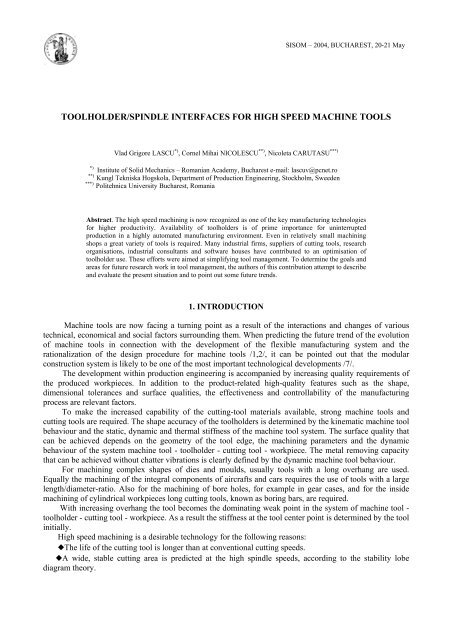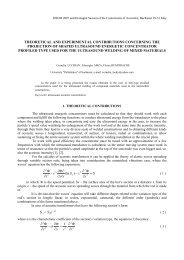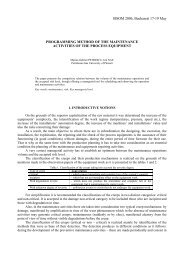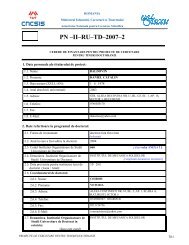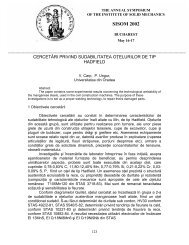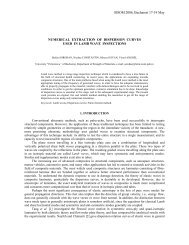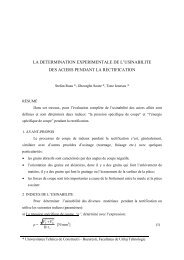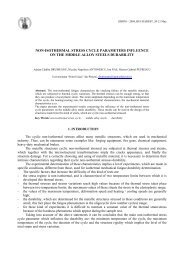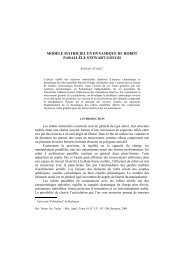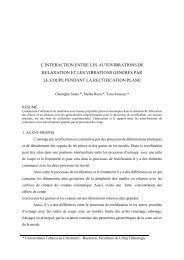error derivation and compensation for cnc machine tools
error derivation and compensation for cnc machine tools
error derivation and compensation for cnc machine tools
You also want an ePaper? Increase the reach of your titles
YUMPU automatically turns print PDFs into web optimized ePapers that Google loves.
SISOM – 2004, BUCHAREST, 20-21 May<br />
TOOLHOLDER/SPINDLE INTERFACES FOR HIGH SPEED MACHINE TOOLS<br />
*)<br />
Vlad Grigore LASCU *) , Cornel Mihai NICOLESCU **) , Nicoleta CARUTASU ***)<br />
Institute of Solid Mechanics – Romanian Academy, Bucharest e-mail: lascuv@pcnet.ro<br />
**)<br />
Kungl Tekniska Hogskola, Department of Production Engineering, Stockholm, Sweeden<br />
***)<br />
Politehnica University Bucharest, Romania<br />
Abstract. The high speed machining is now recognized as one of the key manufacturing technologies<br />
<strong>for</strong> higher productivity. Availability of toolholders is of prime importance <strong>for</strong> uninterrupted<br />
production in a highly automated manufacturing environment. Even in relatively small machining<br />
shops a great variety of <strong>tools</strong> is required. Many industrial firms, suppliers of cutting <strong>tools</strong>, research<br />
organisations, industrial consultants <strong>and</strong> software houses have contributed to an optimisation of<br />
toolholder use. These ef<strong>for</strong>ts were aimed at simplifying tool management. To determine the goals <strong>and</strong><br />
areas <strong>for</strong> future research work in tool management, the authors of this contribution attempt to describe<br />
<strong>and</strong> evaluate the present situation <strong>and</strong> to point out some future trends.<br />
1. INTRODUCTION<br />
Machine <strong>tools</strong> are now facing a turning point as a result of the interactions <strong>and</strong> changes of various<br />
technical, economical <strong>and</strong> social factors surrounding them. When predicting the future trend of the evolution<br />
of <strong>machine</strong> <strong>tools</strong> in connection with the development of the flexible manufacturing system <strong>and</strong> the<br />
rationalization of the design procedure <strong>for</strong> <strong>machine</strong> <strong>tools</strong> /1,2/, it can be pointed out that the modular<br />
construction system is likely to be one of the most important technological developments /7/.<br />
The development within production engineering is accompanied by increasing quality requirements of<br />
the produced workpieces. In addition to the product-related high-quality features such as the shape,<br />
dimensional tolerances <strong>and</strong> surface qualities, the effectiveness <strong>and</strong> controllability of the manufacturing<br />
process are relevant factors.<br />
To make the increased capability of the cutting-tool materials available, strong <strong>machine</strong> <strong>tools</strong> <strong>and</strong><br />
cutting <strong>tools</strong> are required. The shape accuracy of the toolholders is determined by the kinematic <strong>machine</strong> tool<br />
behaviour <strong>and</strong> the static, dynamic <strong>and</strong> thermal stiffness of the <strong>machine</strong> tool system. The surface quality that<br />
can be achieved depends on the geometry of the tool edge, the machining parameters <strong>and</strong> the dynamic<br />
behaviour of the system <strong>machine</strong> tool - toolholder - cutting tool - workpiece. The metal removing capacity<br />
that can be achieved without chatter vibrations is clearly defined by the dynamic <strong>machine</strong> tool behaviour.<br />
For machining complex shapes of dies <strong>and</strong> moulds, usually <strong>tools</strong> with a long overhang are used.<br />
Equally the machining of the integral components of aircrafts <strong>and</strong> cars requires the use of <strong>tools</strong> with a large<br />
length/diameter-ratio. Also <strong>for</strong> the machining of bore holes, <strong>for</strong> example in gear cases, <strong>and</strong> <strong>for</strong> the inside<br />
machining of cylindrical workpieces long cutting <strong>tools</strong>, known as boring bars, are required.<br />
With increasing overhang the tool becomes the dominating weak point in the system of <strong>machine</strong> tool -<br />
toolholder - cutting tool - workpiece. As a result the stiffness at the tool center point is determined by the tool<br />
initially.<br />
High speed machining is a desirable technology <strong>for</strong> the following reasons:<br />
◆The life of the cutting tool is longer than at conventional cutting speeds.<br />
◆A wide, stable cutting area is predicted at the high spindle speeds, according to the stability lobe<br />
diagram theory.
81<br />
Toolholder/spindle interfaces <strong>for</strong> high speed <strong>machine</strong> <strong>tools</strong><br />
◆Most of the heat generated in cutting is transmitted to the chip.<br />
Drilling is a widely used machining process; it is estimated that in 1991 approximately $1.62 billion<br />
was spent in the production of drill bits in the U.S.A. /12/. Important applications can be found in the<br />
automotive, aircraft <strong>and</strong> computer industries as well as fields such as medical science <strong>and</strong> equipment.<br />
Despite its wide use, drilling remains a poorly understood manufacturing process where current difficulties<br />
include poor hole quality, burr <strong>for</strong>mation, chip clogging, excessive heat generation, <strong>and</strong> tool breakage. Drill<br />
bit vibration /9/, in particular, has been recognized as an underlying cause of some of the problems<br />
associated with the drilling process. There<strong>for</strong>e, the design of the toolholders requires solving specific<br />
questions.<br />
2. INTERFACE TOOLHOLDER/ SPINDLE OF MACHINE TOOLS<br />
The result of high speed cutting depends decisively on the interface toolholder/spindle <strong>and</strong> on the<br />
clamping system which must operate under especially difficult conditions. The interface is situated directly<br />
in the <strong>for</strong>ce flow between workpiece <strong>and</strong> <strong>machine</strong>. The optimum design must guarantee the rapid automatic<br />
tool change <strong>and</strong> high per<strong>for</strong>mance functions as well as highest changing <strong>and</strong> repeating accuracy. In addition<br />
to the general requirements on cutting (<strong>for</strong> example the transmission of torque <strong>and</strong> cutting <strong>for</strong>ces), there are<br />
additional dem<strong>and</strong>s on high speed cutting machining: small balance <strong>error</strong>, high concentricity, high runout<br />
tolerance <strong>and</strong> position accuracy, reduced centrifugal <strong>for</strong>ce influenced by small radial dimensions <strong>and</strong> masses.<br />
There are many design approaches to attaching tooling structures to the <strong>machine</strong> tool spindle /3,13/.<br />
Historically, national <strong>and</strong> international st<strong>and</strong>ards <strong>for</strong> toolholders have not been comprehensive or precise<br />
enough to meet the accuracy requirements of new tooling systems or <strong>machine</strong> <strong>tools</strong> designed to operate at<br />
higher cutting speeds. Toolholders do not often fit well into the spindle shafts, since clearances due to<br />
manufacturing tolerances are present, which is unacceptable in many cases; this allows <strong>for</strong> toolholder tilting<br />
<strong>and</strong> out-of-roundness, which results in poor accuracy, repeatability <strong>and</strong> rigidity. There<strong>for</strong>e, toolholder<br />
quality, dimensional tolerances, <strong>and</strong> axial alignment vary broadly from manufacturer to manufacturer /14/.<br />
The important structural <strong>and</strong> dynamic characteristics of a tooling structure interface are the<br />
manufacturing tolerances, static <strong>and</strong> dynamic runout /8/, radial <strong>and</strong> axial positioning accuracy <strong>and</strong><br />
repeatability, connection rigidity (static <strong>and</strong> dynamic stiffness), <strong>for</strong>ce transmission capability, momentum<br />
<strong>and</strong> torque characteristics, clamping <strong>for</strong>ces, balance requirements, fatigue life <strong>and</strong> durability, retention <strong>for</strong>ce<br />
requirements, safety, locking/unlocking <strong>for</strong>ces, coolant capability, maintenance requirements, sensitivity to<br />
contamination, <strong>and</strong> cost.<br />
The total deflection of the tool is the sum of the deflections of the tool body, holder, bearings, <strong>and</strong><br />
spindle (including the <strong>machine</strong> structure). It is obviously desirable to reduce the total deflection.<br />
Fig.1 Chuck de<strong>for</strong>mations influenced by centrifugal <strong>for</strong>ces<br />
Because of the high speed there are centrifugal effects both on the spindle cone <strong>and</strong> the tool taper<br />
(Fig.1). Here the spindle exp<strong>and</strong>s more than the tool, so that the tool axially displaces itself by the clamping
Vlad Grigore LASCU, Cornel Mihai NICOLESCU, Nicoleta CARUTASU 82<br />
<strong>for</strong>ce. By these de<strong>for</strong>mations the contact surfaces are diminished <strong>and</strong> there<strong>for</strong>e the frictionally engaged<br />
transmission of torque occurs. Furthermore the centering of the tool is no longer guaranteed. After stopping<br />
the spindle rotation the elastic de<strong>for</strong>mation diminishes, a press fit develops which is difficult to release. The<br />
axial offset can be prevented by implementing facing stops /3/. Strait shank <strong>tools</strong> can be clamped by a chuck<br />
or a hydraulic expansion chuck. Their functional properties are no longer sufficient by modern st<strong>and</strong>ards.<br />
3. OPTIMIZATION OF THE TOOL HOLDING FIXTURE<br />
A further possible optimization of the dynamic behaviour of <strong>tools</strong> with a long overhang is offered by a<br />
damped tool holding fixture. Here, a statically flexible element with a reasonably high damping is arranged<br />
between the tool <strong>and</strong> tool holding fixture into the line of <strong>for</strong>ce. In spite of the static compliance the element<br />
has to guarantee a high guidance accuracy of the cutting tool.<br />
A straight shank holder can be mounted in a hydraulic expansion sleeve in the hydraulic chuck that is<br />
activated manually or semi-automatically. This provides 360° uni<strong>for</strong>m pressure which clamps the toolholder<br />
concentrically, <strong>and</strong> uni<strong>for</strong>m contact is achieved over the full length of engagement; the clearance between<br />
the toolholder shank <strong>and</strong> the hydraulic sleeve should be smaller than 0.015 mm <strong>for</strong> proper gripping.<br />
The simplified model <strong>for</strong> the calculation of the additional element corresponds to that of a two-degreeof-freedom<br />
system. The tool is approximated as a system with one-degree-of-freedom. Its mass <strong>and</strong> stiffness<br />
are determined by the first natural bending mode /4,5,6/. The damping of the tool shaft results from the<br />
material internal damping only. The mass at the bottom of the two-degree-of-freedom system represents the<br />
additional element <strong>for</strong> the optimization of the dynamic tool behaviour. The static stiffness at the tool center<br />
point decreases as a result of the additional element of the damped tool holding fixture placed in series.<br />
However, a raised static compliance is often approved in the several applications of machining if the<br />
dynamic system stability is increased clearly by it. Providing a suitable calculation <strong>and</strong> design of the<br />
damping element in the tool holding fixture, this can be achieved. For the generation of high damping the<br />
visco-elastic material effect seems to be suitable.<br />
Fig.2. Basic design of the damped tool holding fixture<br />
The basic design of the implemented tool holding fixture with raised damping is shown (Fig.2). The<br />
tool is tied to the tool holding fixture by a membrane that operates as a spring. The visco-elastic material<br />
operates in the rear end of the system located between the extended tool shank <strong>and</strong> the tool holding fixture.<br />
Circumferential grooves serve as oil reservoirs from which the replaced oil flow into the gap.<br />
Through realizing a suitable calculation <strong>and</strong> design of the spring <strong>and</strong> of the damping element the tool<br />
holding fixture's dynamic behaviour can be improved considerably. A comparison of the dynamic frequency
83<br />
Toolholder/spindle interfaces <strong>for</strong> high speed <strong>machine</strong> <strong>tools</strong><br />
responses <strong>for</strong> a drilling cutter with diameter D = 20 mm <strong>and</strong> a length/diameter ratio of 8, measured at the<br />
TCP was realized (Fig.3). The frequency response is represented <strong>for</strong> the fixture of the tool in a hydraulic<br />
chuck, in the dampened tool holding fixture without <strong>and</strong> with visco-elastic materials.<br />
Fig.3 Measured dynamic frequency response of the damped tool holding fixture.<br />
Using the damped tool holding fixture the static compliance raises from 0,65 µm/N to 0,9 µm/N. Here,<br />
the dynamic behaviour is optimized such that no relevant resonance ratio accumulates.<br />
4. RECEPTANCE COUPLING SUBSTRUCTURE ANALYSIS MODEL OF<br />
TOOLHOLDER/SPINDLE<br />
We have also considered the application of Receptance Coupling Substructure Analysis (RCSA) to<br />
prediction of the tool point frequency response function (FRF) in high speed machining /5,6,10, 11/. In this<br />
method, the FRF of the tool (derived from an analytic or finite-element model) is coupled to an experimental<br />
FRF measurement of the toolholder/spindle through appropriate connections to determine the assembly FRF.<br />
Previous results have shown that the dynamic response after system change may be predicted, thereby<br />
reducing the number of required measurements in some applications. For example, RCSA is particularly<br />
relevant to tool tuning /11/, a technique that modifies the system dynamics by adjusting the tool overhang<br />
length in an ef<strong>for</strong>t to improve material removal rates (MRR).<br />
The RCSA model of the toolholder/spindle assembly (fig.4) includes two components, the tool, A, <strong>and</strong><br />
the toolholder/spindle, B, connected by linear <strong>and</strong> rotational springs <strong>and</strong> dampers.
Vlad Grigore LASCU, Cornel Mihai NICOLESCU, Nicoleta CARUTASU 84<br />
Fig.4. RCSA model of the toolholder/spindle.<br />
Using this model, prediction of the tool point FRF proceeds in three steps. First, the component<br />
frequency responses are obtained. The end mill is treated as a free-free beam with an appropriate crosssectional<br />
profile <strong>and</strong> an analytic or finite-element model developed <strong>for</strong> the dynamic response (direct <strong>and</strong><br />
cross FRFs are required at the two ends of the beam). In the mean time, the selected toolholder is placed in<br />
the spindle <strong>and</strong> the free end direct FRF is measured (impact testing was used in this study). Second, the tool<br />
is placed in the toolholder/spindle <strong>and</strong> the connection parameters (k x, c x , k θ , <strong>and</strong> c θ ) are identified usind a<br />
single measurement <strong>and</strong> fit to the experimental data. Third, the complete system model is used to predict the<br />
tool point FRF <strong>for</strong> other tool lengths. The assembly tool point FRF, G 11 (ω), is calculated from the<br />
component receptance <strong>and</strong> mobility terms <strong>and</strong> experimentally determined the connection parameters:<br />
where<br />
E<br />
E<br />
E<br />
E<br />
1<br />
2<br />
3<br />
3<br />
= ( k xH<br />
= ( k xH<br />
= ( kθ<br />
P<br />
= ( k N<br />
θ<br />
G<br />
33<br />
33<br />
33<br />
−1<br />
−1<br />
11 = H11<br />
− H12E1<br />
E2<br />
− L12E3<br />
k N 21 + cθ<br />
N'<br />
21 )<br />
21<br />
−1<br />
+ k xH<br />
22 + cxH<br />
' 33+<br />
cxH<br />
' 22 −1)<br />
− E3<br />
E4<br />
( k xL<br />
−1<br />
+ cxH<br />
' 21 ) − E3<br />
( kθ<br />
N 21 + cθ<br />
N'<br />
21 )( k xL33<br />
+ k<br />
+ kθ<br />
P22<br />
+ cθ<br />
P'<br />
33+<br />
cθ<br />
P'<br />
22 + 1)<br />
+ k N + c N'<br />
+ c N'<br />
)<br />
θ<br />
22<br />
θ<br />
33<br />
θ<br />
22<br />
( θ − E E E<br />
(1)<br />
33<br />
x<br />
22<br />
4<br />
−1<br />
1<br />
+ k xL22<br />
+ cxL'<br />
33+<br />
cxL'<br />
L + c L'<br />
+ c L'<br />
)<br />
The receptance terms relate displacement to <strong>for</strong>ce, H, displacement to moment, L, rotation to <strong>for</strong>ce, N,<br />
<strong>and</strong> rotation to moment, P . The mobility terms, denoted H’, L’, N’, <strong>and</strong> P’, are defined similarly, but they<br />
describe the time rate of the change of displacement <strong>and</strong> rotation to applied <strong>for</strong>ce <strong>and</strong> moment. Further<br />
details of the development of this equation will be communicated.<br />
x<br />
33<br />
2<br />
x<br />
22<br />
22<br />
)<br />
(2)<br />
5. CONCLUSION/ SUGGESTIONS FOR FUTURE DIRECTIONS<br />
▲ Future development work in the field of tool management can no longer be approached as an<br />
isolated area. In view of the central importance of the tool between <strong>machine</strong> tool <strong>and</strong> machining process,<br />
various influencing factors must be tachen into consideration.<br />
▲ Future impruvements in the materials employed <strong>for</strong> <strong>tools</strong> <strong>and</strong> new coating techniques will enable<br />
more precise <strong>and</strong> subsequently more process-oriented classification of <strong>tools</strong>, including toolholders.<br />
Toolholder design <strong>and</strong> the selection of tool materials will thus acquire even greater importance than<br />
previously. The available per<strong>for</strong>mance potential can be fully utilized only when an optimal combination of<br />
tool <strong>and</strong> machining task is achieved.<br />
▲ The increase of the technologically optimized cutting speeds <strong>and</strong> feed rates is mainly a questions of<br />
the velocity of <strong>machine</strong> <strong>tools</strong> control systems <strong>and</strong> the feed drive dynamics. In order to reduce the linear <strong>and</strong><br />
rotating masses with equal rigidity <strong>for</strong> all moving parts, the light-weight construction technology must be<br />
consequently promoved.<br />
▲ Machine security devices are still insufficient. Furthermore, there are no design <strong>and</strong> control<br />
directives <strong>for</strong> fast rotating <strong>tools</strong>.
85<br />
Toolholder/spindle interfaces <strong>for</strong> high speed <strong>machine</strong> <strong>tools</strong><br />
▲Material substitution as well as geometric shape optimization leads to increased dynamic stability of<br />
drills, boring bars <strong>and</strong> milling cuters with a high length/diameter - ratio, more <strong>and</strong> more inclination to<br />
dynamic instability appears. By the use of passive damping elements, integrated in the toolholding fixture,<br />
the dynamic behaviour of the toolholder/spindle system can be optimized.<br />
REFERENCES<br />
1. AOYAMA, H., KISHINAMI, T., SAITO, K., A Method of Tool Management Based on an Intelligent Cutting Tools, Advanced<br />
Manufacturing Engineering 1(7), pp.210-216, 1989.<br />
2. FERREIRA, P.M., LU, C.Y., ZHU, X., A Conceptual Model <strong>for</strong> Process Planing, CAM-I Report R-90-PP-01, Arlington,<br />
University of Technology, 1990<br />
3. HAHNER, W., RONDE, U., Fertigung mit Motorspindelen, Werkstatt und Betrieb, 125(2), pp. 113-122, 1992<br />
4. HEISEL, U., MILBERG, J., Vibrations <strong>and</strong> Surface Generation in SlabMilling, Annals of CIRP 43 (1), pp.337-340, 1994<br />
5. KUSTER, F.., GYGAX, P.E., Cutting Dynamics <strong>and</strong> Stability of Boring Bars, Annals of CIRP 39 (1), pp.361-366, 1990.<br />
6. MAIA, N.M.M., MONTALVAO e SILVA, J.M., Theoretical <strong>and</strong> Experimental Modal Analysis, John Wiley, New York, 1997<br />
7. MITSUISHI, M., WARISAWA, S., HANAYAMA, R., Development of an Intelligent High-Speed Machining Center, Annals of<br />
CIRP 50 (1), pp.275-280, 2001.<br />
8. POLLMANN, E., VERMEULEN, M., Compressibility <strong>and</strong> Inertia Effects on the Dynamic Behaviour of Recessed Hydrostatic<br />
Bearings, Tribology International 22 (3), pp.166-176, 1989.<br />
9. RINCON, D.M., ULSOY, A.G., Effect of Drill Vibrations on Cutting Forces <strong>and</strong> Torque, Annals of CIRP 43 (1), pp.59-62, 1994.<br />
10. SCHMITZ, T., DONALDSON, R., Predicting High-Speed Machining Dynamics by Substructure Analysis, Annals of CIRP 49<br />
(1), pp.303-308, 2000.<br />
11. TLUSTY, J., SMITH, S., WINFOUGH, W., Techniques <strong>for</strong> the Use of Long Slender End Mills in High-Speed Machining, ,<br />
Annals of CIRP 45 (1), pp.393-396, 1996<br />
12. U.S. Department of Commerce, U.S. Industrial Outlook 1992: Business Forecasts <strong>for</strong> 350 Industries, Washington, D.C., 1992<br />
13. WECK, M., KOCH, A., Spindle-Bearing Systems <strong>for</strong> High-Speed Applications in Machine Tools, Annals of CIRP 42 (1), pp.445-<br />
448, 1993.<br />
14. WECK, M., SCHUBERT, I., New Interface Machine/Tool: Hollow Shank, Annals of CIRP 43 (1), pp.345-348, 1994<br />
15. WOWK, V., Machinery Vibration. Measurement <strong>and</strong> Analysis, Mc Graw Hill, New York, 1991


